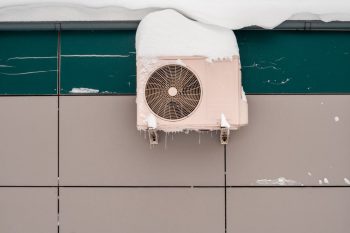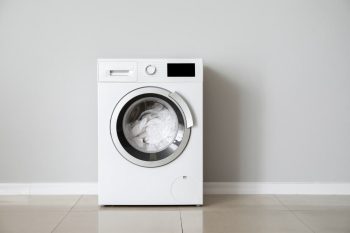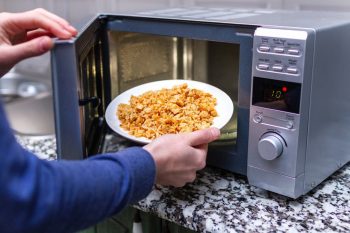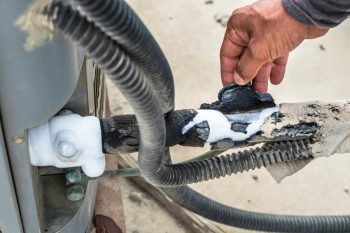
Cleaning a microwave may seem like a simple task, but when mold enters the picture, the process becomes a bit more complex. Mold, a type of fungus that thrives in damp environments, can pose a significant health risk if not dealt with promptly. In this comprehensive guide, we’ll walk you through the steps on how to clean mold out of a microwave, discuss the potential health risks, and provide tips to prevent future mold growth.
To clean mold out of a microwave, first unplug the microwave for safety. Prepare a cleaning solution of mild liquid detergent and water, then scrub the mold patches inside the microwave. After removing the mold, clean the entire interior, rinse, and thoroughly dry. Disinfect the microwave with a solution of equal parts white vinegar and water, microwaving it until it boils and letting it sit for about 30 minutes. Finally, clean the glass plate and exterior with warm soapy water or a vinegar solution. Prevent future mold growth by keeping the microwave clean and dry, and addressing any moisture issues promptly.
Spotting Mold in Your Microwave
One of the first indications of mold in a microwave is an unpleasant, musty odor. If you notice any unusual spots or discoloration inside the microwave, it could be mold. Mold can appear in various colors, such as white, black, green, or pink, and may have a fuzzy or slimy texture. Allergy-like symptoms after using the microwave could also be a sign of mold exposure.
Health Risks Associated with Mold in a Microwave
Mold can trigger adverse health reactions, respiratory problems, and allergic reactions. Some molds produce mycotoxins, which may suppress the immune system and contribute to symptoms such as depression, anxiety, muscle cramps, numbness in extremities, weight gain, and hair loss. Even dead mold can cause health issues as it can still release spores and mycotoxins.
Essential Tools and Cleaning Agents
Before you start cleaning, gather the following:
- Protective gear (gloves and mask)
- White vinegar
- Baking soda
- Liquid detergent
- Sponge or cloth
- Bowl
Step-by-Step Cleaning Process
- Unplug the Microwave: Always unplug the microwave before cleaning to avoid any electrical hazards.
- Prepare a Cleaning Solution: Mix mild liquid detergent with water in a bowl.
- Clean the Mold: Use a sponge or a small towel soaked in the detergent solution to gently scrub the mold patches inside the microwave.
- Clean the Entire Interior: After removing the mold, clean the entire interior of the microwave until you are satisfied with its cleanliness.
- Rinse and Dry: Rinse the interior with clean water and a clean cloth or sponge. Then, thoroughly dry the interior of the microwave to eliminate moisture.
- Disinfect with Vinegar: Prepare a solution of equal parts white vinegar and water. Microwave it for a few minutes until it boils. Let the vinegar solution sit in the microwave for about 30 minutes to kill any remaining mold spores. Wipe down the interior again with a clean cloth or sponge.
- Clean the Glass Plate and Exterior: Wash the glass plate with warm soapy water, rinse, and dry it before placing it back in the microwave. Clean the exterior of the microwave with a solution of water and vinegar or lemon juice.
Preventing Future Mold Growth
Preventing mold growth in your microwave involves routine cleaning and moisture control. Wipe the microwave after each use, make sure it’s thoroughly dried, and clean it at least once a week or twice a month. Use a microwave-safe cover to prevent food splatters, and ensure proper ventilation by leaving the microwave door open for a few minutes after use.
Conclusion
Keeping your microwave clean and dry is the key to preventing mold growth. If you notice mold, take immediate action to clean it and address any moisture issues. If mold keeps returning despite regular cleaning, consider hiring a professional mold remediation company. Remember, a clean microwave is not just about aesthetics; it’s also about your health and safety.
Frequently Asked Questions
Can I use bleach to clean the mold in my microwave?
Yes, you can use bleach to clean mold in the microwave. However, it’s important to use it in a well-ventilated area and rinse thoroughly afterwards to avoid leaving any residue.
Is it safe to use a microwave if there is mold inside?
No, it is not safe to use a microwave if there is mold inside. Mold can contaminate the food you cook in the microwave and cause health issues. Therefore, it’s important to clean the mold out of your microwave before using it.
What if the mold is not visible but there is a musty smell in my microwave?
If there’s a musty smell but no visible mold, it’s possible that the mold is in a hidden area, like the ventilation system. In this case, it’s best to hire a professional to inspect and clean your microwave.
Can I prevent mold growth by leaving the microwave door open after use?
Yes, leaving the microwave door open after use can help prevent mold growth. This allows moisture to evaporate instead of being trapped inside, creating a less desirable environment for mold to grow.
How often should I clean my microwave to prevent mold growth?
It’s recommended to clean your microwave at least once a week or twice a month. However, if you use your microwave frequently, you may need to clean it more often.












